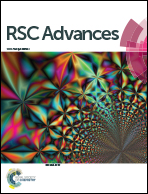Amine post-functionalized POSS-based porous polymers exhibiting simultaneously enhanced porosity and carbon dioxide adsorption properties†
Abstract
A novel hybrid porous polymer (HPP-1) is synthesized using octavinylsilsequioxane and 2,7-dibromo-9-fluorenone as monomers via Heck reaction. Subsequently, HPP-1 is post-functionalized by the conversion of deliberately introduced free ketone moieties into amine functionalities. Compared with HPP-1, the resulting material, HPP-1-amine, showed enhanced CO2 uptake from 0.63 mmol g−1 (HPP-1) to 1.01 mmol g−1 (HPP-1-EDA, EDA = ethylenediamine) and 0.72 mmol g−1 (HPP-1-HDA, HDA = hexamethylenediamine) at 298 K and 1 bar. Furthermore, the porosity of HPP-1-amine is not compromised, but enhanced with the BET specific surface area increasing from 529 m2 g−1 (HPP-1) to 651 m2 g−1 (HPP-1-EDA) and 615 m2 g−1 (HPP-1-HDA). Compared with HPP-1, the selectivity of CO2 over N2 of HPP-1-EDA increases nearly twice while that of HPP-1-HDA slightly decreases, indicating their potential applications in CO2 storage and capture. Although the enhanced extent of CO2/N2 selectivity is not as high as other analogues, we provide a new possibility for post-synthetic amine functionalization of porous polymers for simultaneously enhancing porosity and CO2 adsorption properties. The retained porosity won't limit their applications in other areas, such as heavy metal ion adsorption, ion channels and catalysis, etc.


 Please wait while we load your content...
Please wait while we load your content...